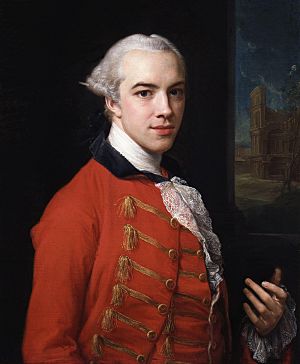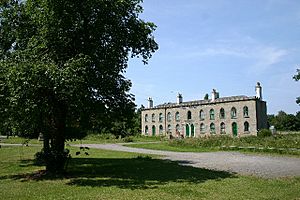Philip Metcalfe facts for kids
Quick facts for kids
Philip Metcalfe
|
|
|---|---|

Portrait (c. 1766–1767), oil on canvas, by Pompeo Batoni (1708–1787), National Portrait Gallery, London
|
|
| Personal details | |
| Born | 29 August 1733 London |
| Died | 26 August 1818 (aged 84) Brighton, Sussex |
| Nationality | English |
| Residences | Hawstead House, Hawstead, Suffolk |
| Occupation | Member of Parliament, Industrialist |
Philip Metcalfe (29 August 1733 – 26 August 1818) was an important English politician, a successful business owner, and someone who helped others. He was a member of the Tory political party. He was also known for making malt spirits and for his generous acts of charity.
His family came from Yorkshire and were Catholic. They supported the King during the English Civil War.
Family and Early Life
Philip Metcalfe was born in London on 29 August 1733. He was the second son of Roger Metcalfe, a surgeon, and Jemima Astley. He was named after his grandfather, Sir Philip Astley.
Philip's mother, Jemima, later married Henry Groome. Henry was a linen seller and also worked as the Keeper of the Guildhall.
It is believed that Philip Metcalfe learned his business skills from Robert Jones. Robert Jones was a wine merchant and a director of the East India Company. He was also a member of Parliament. Philip Metcalfe became involved in the Three Mills business in 1759. This was a large industrial site. Over time, Metcalfe became the leader of the Three Mills distillery. This is where they made spirits like gin.
Business and Political Career
Philip Metcalfe was the head of a company called Metcalfe and Co. This was a distillery in West Ham, Essex. A distillery is a place where alcoholic drinks are made. His brothers, Christopher and Roger, were also partners in the business.
Metcalfe became a Member of Parliament (MP) in 1784. An MP is a person elected to represent a group of people in the country's government. He represented different areas over the years, including Horsham, Plympton Erle, and Malmesbury.
During his time in Parliament, Metcalfe usually voted with William Pitt the Younger, who was a very powerful politician. For example, he supported Pitt's plan to build forts along the southern coast of England. He also stood with Pitt during the important Regency Bill of 1789.
Arts and Culture
Because of his success in the gin trade, Philip Metcalfe became very wealthy. He used his money to collect art and support artists. This means he was a patron of the arts. He had many famous friends, including the writer Samuel Johnson and the painter Sir Joshua Reynolds.
Two portraits of Philip Metcalfe are kept at the National Portrait Gallery. One was painted by Pompeo Batoni.
Philip Metcalfe was also chosen to help manage the will of his friend, the famous painter Joshua Reynolds.
He joined several important groups that focused on arts and knowledge:
- In 1760, he joined the Royal Society of Arts.
- In 1785, he became a member of the Society of Antiquaries of London. This group studies history and old objects.
- In 1786 and 1790, he was elected to the Society of Dilettanti and the Royal Society. These were groups for people interested in art, science, and learning.
Metcalfe was also a member of a famous dining group called The Club. He was one of the people who signed a special letter, called a Round Robin. This letter asked Dr. Johnson to change the poem he wrote about the poet Oliver Goldsmith.
Legacy
Philip Metcalfe left behind some important buildings.
Between 1815 and 1817, he built a new mill at the Three Mills site. It was called the Clock Mill. He had his initials, PM, carved into the building.
Metcalfe was also known for his charity work. In 1811, he built the Alms House in Hawstead. These houses were for "the benefit of the Aged and Deserving Poor." This means they provided homes for elderly people who needed help.
Later Life
Philip Metcalfe never married. He passed away in Brighton, Sussex, on 26 August 1818, when he was 85 years old. He was buried a week later at St Nicholas church.
When he died, his property and money were worth a lot, about £400,000. His great-nephew, Henry Metcalfe, inherited his wealth.
|



